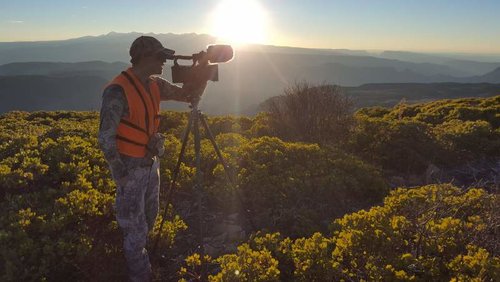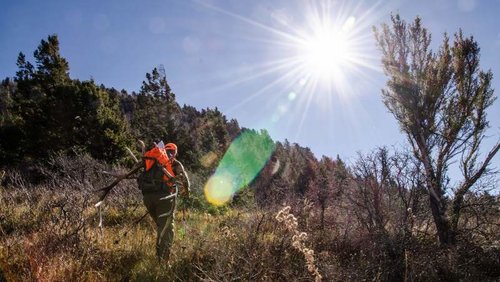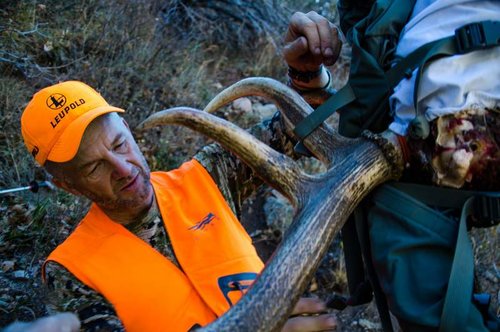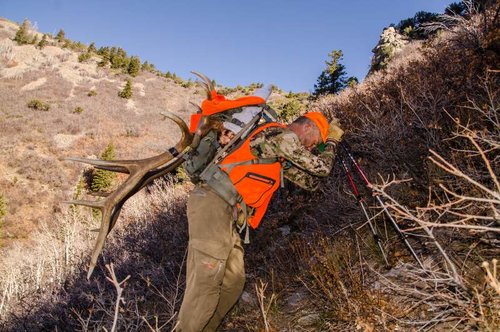Since we were on the road for the two months following our Colorado elk hunt, I never got a chance to post the notes of this hunt, which I have since filled in with more details for a magazine that has asked for the story. Not sure if it will get published or in what format, so I figured I may as well post it here and get some use out of the hours spent writing it.
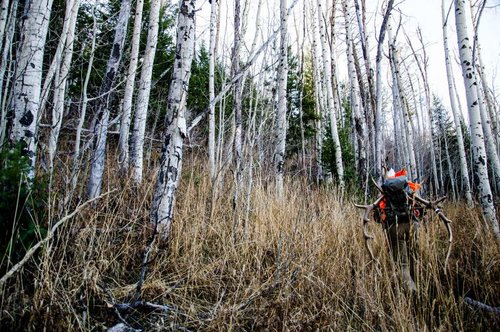
Somethings in life are worth waiting for. Some things worth fighting for. All, worth living for. Chasing elk in the wild Colorado canyons cover all the above.
Laying in my tent, my mind rolled back to the first time I mailed money to Colorado, hoping I would be chasing elk on this mesa, on these public lands. Licking that envelope, I could not have imagined it would be nineteen years of rejection until, the twentieth attempt, when I would stand atop the preference point pile and do what I had dreamed of two decades prior.
My last waking thoughts was the antlered herd we spotted just before dark, scattered in small bachelor groups as post-rut bulls will do; hunkered down in the worst terrain, far from motors, daring any elk hunter to make the hike to chase them. And daring them further to pull the trigger and starting what would surely be a multi-day extraction of meat, hide, and trophy.
Sleep comes easy in the pure air of 9,000’ in the Colorado Rockies. Alarms come early, validating my friend’s favorite rise and shine line, “Doesn’t take long to spend the night around here.” No, it didn’t.
No time for my morning coffee ritual. Calling me was a pre-dawn hike to a glassing ridge where the southeast sun would hopefully illuminate these bulls, outlining one of them to be worth waiting forty-percent of my living years for this chance to match wits and skill. A brisk hour hike, following an hour in the UTV, would give me time to reflect on the journey to get here, the elk these canyons conceal, and with any luck, a plan to notch a tag.
Waiting for glassing light tests every hunter’s patience, even those with a quarter century experience. I kept peering through the spotter, dialing the magnification down to 15X, hoping to capture what little light was advancing. I smiled, thinking how many mornings I had repeated that same exercise, always with the same result; blurry objects my mind wanted to confirm as elk.
Age trains one to better handle frustrations born of impatience. I rummaged through my pack for the banana bread that is more than my wife’s fine baking; her good luck token and a reminder that she finds happiness in my happiness. Sniffing and inspecting this treat passed enough minutes that when I returned to the spotter the images were less blurry, though still not wearing obvious antlers.
My layers, once moist from sweating to climb here, dried quickly as morning thermals coursed this large basin from where an impenetrable sandstone canyon disappeared. Last evening’s bulls, if spotted today, would require my greatest navigation talent. No passage seemed to exist. Waiting for more light, I pulled my GPS to solve the canyon’s riddle. If a route existed, the topo lines, stacked thick and discouraging, hid it.
With my naked eye, the closer images could be identified. High elevation faces across this huge chasm accepted the first full morning light. Time to angle my glass there, then grid my way east across the face, and chase the dropping shadow line to the low country.
Sometimes luck finds you. My first roll of the spotter’s focus wheel seemed to have an elk. Yup, an elk, antlers included. I had not even panned the scope and here was an elk. And given antlers could be seen in this low light, at a mile and a quarter, he obviously was worth investigation. Rolling back the magnification widened my field of view, allowing me to search the edges of the lens in hopes he was not alone. Nope, he’s not alone. Four antlered buddies were enjoying once-burned oaks for breakfast, mixed with an assortment of other greens low -intensity fires deliver.
Yes, after all these years, this seemed worth the wait. The bulls of last night had only moved a few hundred yards, albeit a few hundred mean yards when measured in terms of sheer cliff angles and clothes-tearing oak jungle. Impatience was replaced by hunter’s watching the bulls go about their morning bask, undeterred by the activities of man. Enough distance from humans and discouraging topography put elk at ease. And what this spot lacked in distance, it more than made up for with discouraging topography.
A yellow band of sparsely leaved aspens, spared by the recent fires, rolled off the mesa into this long-running gut, serving as a landmark that would allow me to relocate these bulls when I finished following the sun as it worked its way to the lower benches.
With no distant gun shots, no whining of small motors, I began to wonder, “Am I really on public land; did hunting season really opened this morning?”
This first hour of legal shooting light revealed many elk-colored shapes dotting the terrain across from my glassing position, ranging in distance of one-plus miles to almost two miles. In total, four bachelor groups of bulls and not a single cow to be found. All fed undisturbed, seeming in a random arrangement across the rugged faces, though reasons for being here were far from random; security, sanctuary, escapement, rare late-season food in the quality and abundance only a fire can bring, and probably most driven by instinct.
With so many candidates to chase, I drew my map from my pack and laid it out on a large rock still trying to shed the night’s frost. Comparing the big map to my GPS chip revealed the reasons for such an accumulation of elk. The nearest road came from the northwest, but crossed a large section of State Trust Land. Under Colorado law, these State Trust Lands are off limits to hunting unless you are the lessee. I had inquired of that leaseholder and they explained that their private and State Trust Land property is leased to a hunting group for deer and elk, along with some private hunting of their family. Polite as they were firm, it was apparent that permission to approach across those tamer State Trust Lands was not option. Searching for a silver lining in the access cloud, I rationalized that one benefit of this access challenge was that with no reasonable access across those State Land show as blue on my surface map, this would be a sanctuary; something my desk scouting projected and a discussion with a past tag holder confirmed.

Somethings in life are worth waiting for. Some things worth fighting for. All, worth living for. Chasing elk in the wild Colorado canyons cover all the above.
Laying in my tent, my mind rolled back to the first time I mailed money to Colorado, hoping I would be chasing elk on this mesa, on these public lands. Licking that envelope, I could not have imagined it would be nineteen years of rejection until, the twentieth attempt, when I would stand atop the preference point pile and do what I had dreamed of two decades prior.
My last waking thoughts was the antlered herd we spotted just before dark, scattered in small bachelor groups as post-rut bulls will do; hunkered down in the worst terrain, far from motors, daring any elk hunter to make the hike to chase them. And daring them further to pull the trigger and starting what would surely be a multi-day extraction of meat, hide, and trophy.
Sleep comes easy in the pure air of 9,000’ in the Colorado Rockies. Alarms come early, validating my friend’s favorite rise and shine line, “Doesn’t take long to spend the night around here.” No, it didn’t.
No time for my morning coffee ritual. Calling me was a pre-dawn hike to a glassing ridge where the southeast sun would hopefully illuminate these bulls, outlining one of them to be worth waiting forty-percent of my living years for this chance to match wits and skill. A brisk hour hike, following an hour in the UTV, would give me time to reflect on the journey to get here, the elk these canyons conceal, and with any luck, a plan to notch a tag.
Waiting for glassing light tests every hunter’s patience, even those with a quarter century experience. I kept peering through the spotter, dialing the magnification down to 15X, hoping to capture what little light was advancing. I smiled, thinking how many mornings I had repeated that same exercise, always with the same result; blurry objects my mind wanted to confirm as elk.
Age trains one to better handle frustrations born of impatience. I rummaged through my pack for the banana bread that is more than my wife’s fine baking; her good luck token and a reminder that she finds happiness in my happiness. Sniffing and inspecting this treat passed enough minutes that when I returned to the spotter the images were less blurry, though still not wearing obvious antlers.
My layers, once moist from sweating to climb here, dried quickly as morning thermals coursed this large basin from where an impenetrable sandstone canyon disappeared. Last evening’s bulls, if spotted today, would require my greatest navigation talent. No passage seemed to exist. Waiting for more light, I pulled my GPS to solve the canyon’s riddle. If a route existed, the topo lines, stacked thick and discouraging, hid it.
With my naked eye, the closer images could be identified. High elevation faces across this huge chasm accepted the first full morning light. Time to angle my glass there, then grid my way east across the face, and chase the dropping shadow line to the low country.
Sometimes luck finds you. My first roll of the spotter’s focus wheel seemed to have an elk. Yup, an elk, antlers included. I had not even panned the scope and here was an elk. And given antlers could be seen in this low light, at a mile and a quarter, he obviously was worth investigation. Rolling back the magnification widened my field of view, allowing me to search the edges of the lens in hopes he was not alone. Nope, he’s not alone. Four antlered buddies were enjoying once-burned oaks for breakfast, mixed with an assortment of other greens low -intensity fires deliver.
Yes, after all these years, this seemed worth the wait. The bulls of last night had only moved a few hundred yards, albeit a few hundred mean yards when measured in terms of sheer cliff angles and clothes-tearing oak jungle. Impatience was replaced by hunter’s watching the bulls go about their morning bask, undeterred by the activities of man. Enough distance from humans and discouraging topography put elk at ease. And what this spot lacked in distance, it more than made up for with discouraging topography.
A yellow band of sparsely leaved aspens, spared by the recent fires, rolled off the mesa into this long-running gut, serving as a landmark that would allow me to relocate these bulls when I finished following the sun as it worked its way to the lower benches.
With no distant gun shots, no whining of small motors, I began to wonder, “Am I really on public land; did hunting season really opened this morning?”
This first hour of legal shooting light revealed many elk-colored shapes dotting the terrain across from my glassing position, ranging in distance of one-plus miles to almost two miles. In total, four bachelor groups of bulls and not a single cow to be found. All fed undisturbed, seeming in a random arrangement across the rugged faces, though reasons for being here were far from random; security, sanctuary, escapement, rare late-season food in the quality and abundance only a fire can bring, and probably most driven by instinct.
With so many candidates to chase, I drew my map from my pack and laid it out on a large rock still trying to shed the night’s frost. Comparing the big map to my GPS chip revealed the reasons for such an accumulation of elk. The nearest road came from the northwest, but crossed a large section of State Trust Land. Under Colorado law, these State Trust Lands are off limits to hunting unless you are the lessee. I had inquired of that leaseholder and they explained that their private and State Trust Land property is leased to a hunting group for deer and elk, along with some private hunting of their family. Polite as they were firm, it was apparent that permission to approach across those tamer State Trust Lands was not option. Searching for a silver lining in the access cloud, I rationalized that one benefit of this access challenge was that with no reasonable access across those State Land show as blue on my surface map, this would be a sanctuary; something my desk scouting projected and a discussion with a past tag holder confirmed.




